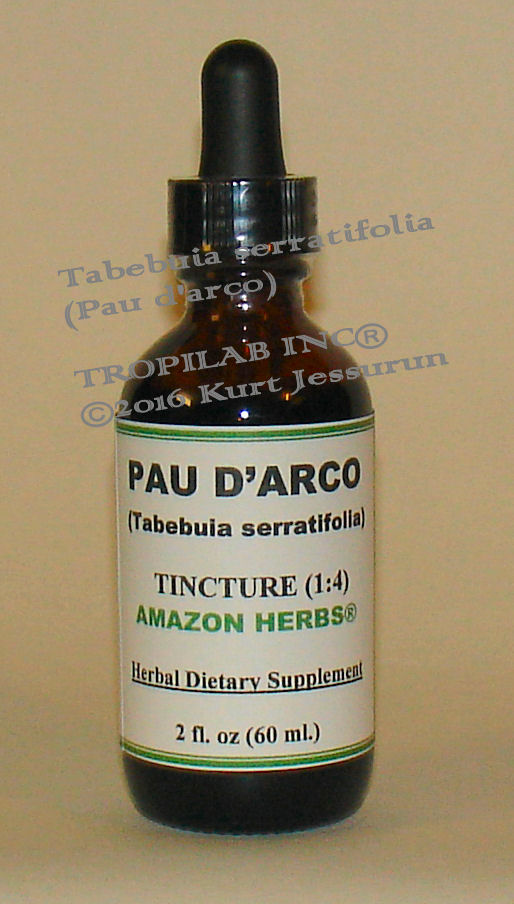Overview
 Pau d'arco (Surinam greenheart or Taheebo) is a huge flowering
tree, native to rainforests throughout Central- and South America.
Pau d'arco (Surinam greenheart or Taheebo) is a huge flowering
tree, native to rainforests throughout Central- and South America.
The inner bark that is used, contains more than 20 active compounds including the flavonoids lapachol, quercetin and
other flavonoids*.
This tree has numerous medicinal applications; the wood is one of the hardest and most sought after
available.
It is one of the largest and strongest of tropical forest trees, growing up to 150 feet tall while the base can be
4 to 7 feet in diameter.
Constituents
Anthraquinones, ascorbic -acid, beta-carotene (carotenoid), beta-sitosterol, beta-lapachone
& lapachol (naphthoquinone compounds), quercetin (bioflavnoid), Calcium, Chromium, Chrysophanic-acid, Cobalt,
Fat, Fiber, Iron, Lapachol, Magnesium, Naphthoquinones, Niacin (vitamin B3), Phosphorus, Potassium, Protein, Riboflavin (vitamin B2),
Selenium, Silicon, Thiamin (vitamin B1), Zinc.
Pharmacology
 Two main bioactive components have been isolated from Tabebuia; lapachol and
ß-lapachone (beta lapachone). The last one is considered to be the main anti-tumor compound. Tumor and pro-apoptotic
effects were observed in vitro. Some mechanistic studies on this compound's molecular effects have been conducted.
The drug appears to be generally safe and one of the most important interactions of this plant has been associated
with interference in the biological cycle of Vitamin K in the body. ß-lapachone inhibits DNA topoisomerase (enzymes controlling
the topology of DNA in all cells).
Two main bioactive components have been isolated from Tabebuia; lapachol and
ß-lapachone (beta lapachone). The last one is considered to be the main anti-tumor compound. Tumor and pro-apoptotic
effects were observed in vitro. Some mechanistic studies on this compound's molecular effects have been conducted.
The drug appears to be generally safe and one of the most important interactions of this plant has been associated
with interference in the biological cycle of Vitamin K in the body. ß-lapachone inhibits DNA topoisomerase (enzymes controlling
the topology of DNA in all cells).
Topoisomerase inhibitors (including beta-lapachone) seem to be effective against several types of cancer, including
lung, breast, colon and prostate cancers and malignant melanoma.
Since cancer cells grow and reproduce at a much faster rate than normal cells, they are more vulnerable to
topoisomerase inhibition than normal cells. Beta-lapachone also interferes with the replication of HIV-1, a virus that causes
AIDS, thereby slowing the advancement of this disease.
Two drugs from the yew tree, Taxol (paclitaxel) and Taxotere (docetaxel) are currently considered to
be the most important drugs in cancer chemotherapy. Both of them have shown some results in treatment of hormone
refractory prostate cancer.
In a preclinical new study published in Proceedings of the National Academy of Sciences, researchers at Dana-Farber
Cancer Institute report that a two-drug therapy using Taxol and beta-lapachone, artificially rebuilds the cell's
quality-control system and can completely destroy human tumor cells grown in laboratory animals.
Applications
Used to treat numerous conditions like bacterial and fungal infections, fever,
syphilis, malaria, trypanosomiasis, as well as stomach and bladder disorders.
Treatment of cancer (inhibit growth of tumors).
Infections (relief of vaginal candidiasis and oral thrush candidiasis).
It has antibiotic and antifungal properties making it a powerful natural antibiotic.
Pau D’Arco is also a very effective antifungal agent. The constituent lapachol has been shown to inhibit the growth of Candida
albicans, Candida tropicalis, and Cryptococcus neoformans.
It is applied directly to the skin for Candida yeast infections.
Pau d’arco is also used against parasitic (intestinal parasites).
Other applications are against respiratory problems and prostatitis.
Dosage
Tincture:
Adults: 30 drop (1 ml), 2 - 3 times a day in water.
Infusion (herbal tea):
1 - 1½ tsp in 1 cup very hot water (8 oz); steep for 20 minutes.
1 cup 1 - 2 times a day; the tea is caffeine free.
Side effects and / or interactions
Nausea and dizziness.
Pau d'arco is a blood thinner and may potentiate the effects of anticoagulations / antiplatelets. It
could interfere as such with blood thinning drugs such as Warfarin (Coumadin), Clopidogrel (Plavix) and Aspirin.
Remarks
Do not take while pregnant or breast feeding; do not take in excessive amounts.
*Flavonoids: these are important antioxidants, and have also many other excellent health effects such as
anti-cancer and antiviral.
References
A Textbook of Natural Medicine.
Willard T.
Edinburgh (England): Churchill Livingstone; 1998.
Oswald EH. Lapacho.
Br J Phytotherapy 1994;3:112-7.
Comparison of antibacterial and antifungal activities of lapachol and beta-lapachone.
Guiraud P, et al.
Planta Med 1994;60:373-4.
Tyler's Honest Herbal: A Sensible Guide to the Use of Herbs and Related Remedies.
Foster S, et al.
New York: Haworth Herbal Press; 1999.
Herb Contraindications and Drug Interactions, 2nd ed.
Brinker F.
Sandy (OR): Eclectic Med Publications; 1998.
The search for novel anticancer agents: a differentiation-based assay and analysis of a folklore product.
Dinnen RD, Ebisuzaki K.
Anticancer Res 1997;17:1027-34.
Early clinical studies with lapachol.
Block JB, et al.
Cancer Chemother Rep 1974; 4:27-8.
The above presentation is for informational and educational purposes only.
It is based on scientific studies (human, animal, or in vitro), clinical experience, or traditional usage.
For many of the conditions discussed, treatment with prescribed (RX) or over - the - counter (OTC) medication is also
available.
Consult your doctor, practitioner, and/or pharmacist for any health problem and before using
dietary supplements or before making any changes in prescribed medications.
|

